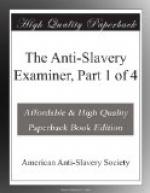Great fault has been found with the prints which have been employed to expose slavery at the North, but my friends, how could this be done so effectively in any other way? Until the pictures of the slave’s sufferings were drawn and held up to public gaze, no Northerner had any idea of the cruelty of the system, it never entered their minds that such abominations could exist in Christian, Republican America; they never suspected that many of the gentlemen and ladies who came from the South to spend the summer months in traveling among them, were petty tyrants at home. And those who had lived at the South, and came to reside at the North, were too ashamed of slavery even to speak of it; the language of their hearts was, “tell it not in Gath, publish it not in the streets of Askelon;” they saw no use in uncovering the loathsome body to popular sight, and in hopeless despair, wept in secret places over the sins of oppression. To such hidden mourners the formation of Anti-Slavery Societies was as life from the dead, the first beams of hope which gleamed through the dark clouds of despondency and grief. Prints were made use of to effect the abolition of the Inquisition in Spain, and Clarkson employed them when he was laboring to break up the Slave trade, and English Abolitionists used them just as we are now doing. They are powerful appeals and have invariably done the work they were designed to do, and we cannot consent to abandon the use of these until the realities no longer exist.
With regard to those white men, who, it was said, did try to raise an insurrection in Mississippi a year ago, and who were stated to be Abolitionists, none of them were proved to be members of Anti-Slavery Societies, and it must remain a matter of great doubt whether, even they were guilty of the crimes alledged against them, because when any community is thrown into such a panic as to inflict Lynch law upon accused persons, they cannot be supposed to be capable of judging with calmness and impartiality. We know that the papers of which the Charleston mail was robbed, were not insurrectionary, and that they were not sent to the colored people as was reported. We know that Amos Dresser was no insurrectionist though he was accused of being so, and on this false accusation was publicly whipped in Nashville in the midst of a crowd of infuriated slaveholders. Was that young man disgraced by this infliction of corporal punishment? No more than was the great apostle of the Gentile; who five times received forty stripes, save one. Like him, he might have said, “henceforth I bear in my body the marks of the Lord Jesus,” for it was for the truth’s sake, he suffered, as much as did the Apostle Paul. Are Nelson, and Garrett, and Williams, and other Abolitionists who have recently been banished from Missouri, insurrectionists? We know they are not, whatever slaveholders may choose to




